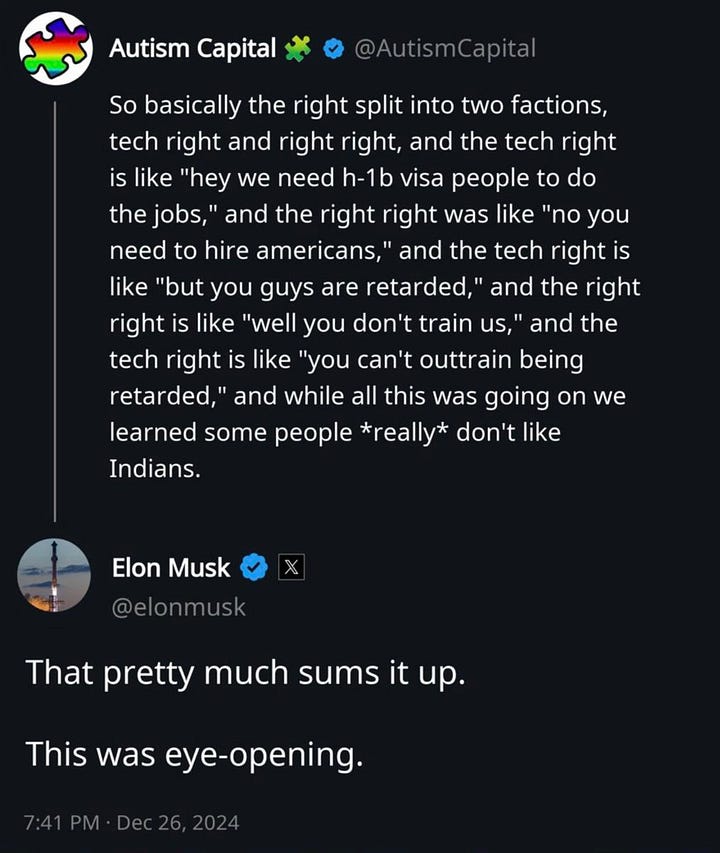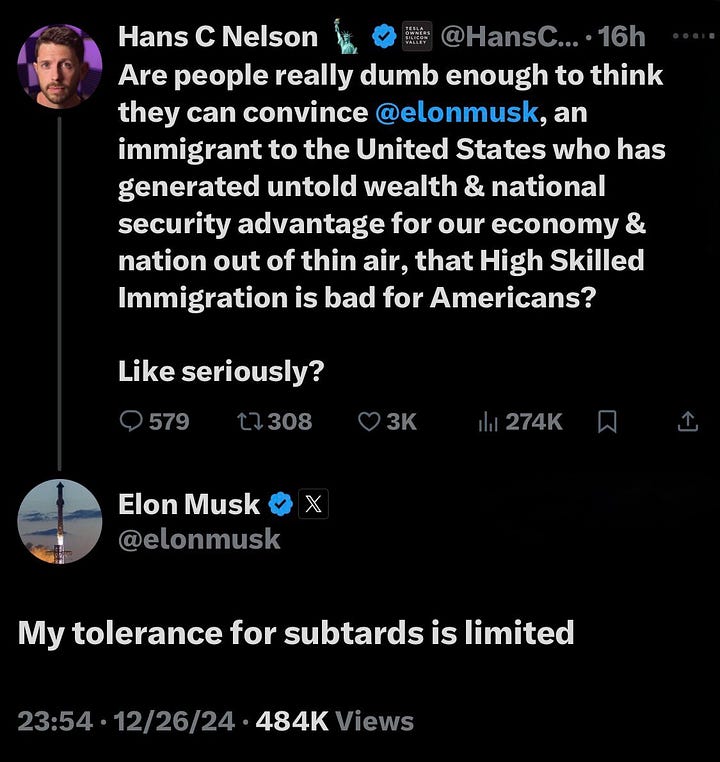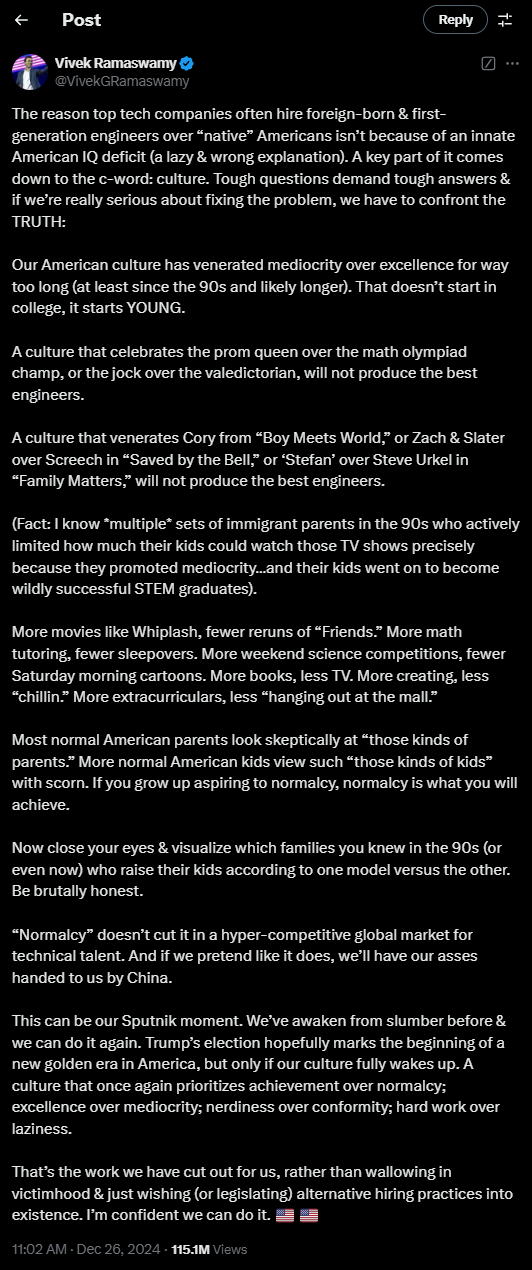MAGA vs. Their Leaders: The H-1B Civil War on X
The Rift Between Trump’s Grassroots Base and Billionaire Allies Over Immigration, Exploitation, and Betrayal
The H-1B Civil War within MAGA reveals a deep divide between grassroots supporters and billionaire leaders like Elon Musk and Vivek Ramaswamy, exposing tensions over immigration, corporate exploitation, and cultural blame. As the movement fractures, it highlights an opportunity for others to address the real struggles of American workers with genuine solutions.
Quick Take & Deep Dive Available
How to Read this Article:
You can click on either Quick Take or Deep Dive below to navigate to the respective section:
Quick Take: A shorter, easy-to-read overview of the H-1B Civil War within MAGA and what it reveals about the movement’s internal divisions.
Deep Dive: A detailed analysis of the week-long controversy, including key players, tensions over immigration, corporate exploitation, and broader implications through the lens of the Unified Societal Operating System (USOS) framework.
Whether you choose the quick version or the detailed one, we’ll explore how this clash exposes the cracks within MAGA’s foundation and what it means for the future of American workers, leadership, and political opportunity.
Quick Take
The H-1B Civil War on X
The fight over H-1B visas has blown up into a full-on civil war within MAGA, pitting grassroots supporters against some of their most high-profile leaders, like Elon Musk, Vivek Ramaswamy, and even Donald Trump himself. Here’s what happened—and why it matters.
It all started when Trump announced venture capitalist Sriram Krishnan as his senior adviser on AI policy. MAGA activist Laura Loomer immediately slammed the move as a betrayal of Trump’s America First agenda. She took things further, blaming immigration for undermining American workers, and even veered into inflammatory rhetoric about who built America.
Then Elon Musk jumped in. Musk, who’s personally benefited from the H-1B program, argued that America simply doesn’t have enough “super talented and super motivated” engineers and compared hiring foreign talent to building a championship sports team. But his blunt—and downright insulting—comments rubbed many MAGA supporters the wrong way. He called his critics “subtards” and backed a claim that MAGA grievances about job training boil down to people being “retarded.”
Cue the backlash. One MAGA supporter shared the story of their son, a recent engineering grad who can’t even get an interview. Musk didn’t engage with the criticism; instead, he doubled down, insisting the U.S. needs to hire the best talent in the world, no matter where it’s from.
As if things couldn’t get worse, Vivek Ramaswamy piled on with his take: the problem isn’t immigration—it’s American culture. He claimed our culture “venerates mediocrity over excellence,” drawing outrage from MAGA loyalists who felt he was blaming them for systemic problems.
And Trump? He tried to walk the tightrope, saying he supports H-1B visas and even uses them at his own businesses. But for many MAGA supporters, that felt like another betrayal, deepening the divide between the grassroots base and the billionaire leaders they once idolized.
At its core, this fight isn’t just about immigration. This isn’t just a MAGA issue—it’s a reflection of a system where corporate profits are prioritized over people’s livelihoods. Grassroots supporters see themselves as the backbone of America, but their leaders seem more interested in protecting corporate profits than addressing the struggles of everyday workers. It’s a clash between populist rhetoric and elite interests, and it’s exposing cracks in MAGA’s foundation.
For Democrats—or anyone looking to capitalize on this rift—it’s a golden opportunity. By addressing the real pain of American workers with tangible solutions—investing in education, holding corporations accountable, and ensuring fairness in immigration—they could reclaim the mantle of the party that truly represents the people. The question is, who’s willing to step up and take it?
Deep Dive
The Facts: A Week of Controversy
The Controversy Begins: A New Appointment Sparks Outrage
Here’s where it all started: President-elect Donald Trump announced that Sriram Krishnan, a venture capitalist with a reputation for supporting skilled immigration reforms, would be his senior adviser on AI policy. For Trump’s grassroots supporters, this move wasn’t just controversial—it felt like a betrayal.
Leading the charge was Laura Loomer, a far-right activist with a knack for stirring the pot. Loomer took to X.com (formerly Twitter) to blast the appointment as “deeply disturbing” and a direct contradiction of Trump’s “America First” promises. Her words hit hard with the MAGA base, setting the stage for a week-long feud between Trump’s elite allies and his most loyal followers.
But Loomer didn’t stop at policy criticism. She veered into inflammatory territory, claiming that America was built by “white Europeans” rather than immigrants from places like India. Naturally, this kind of rhetoric drew backlash. Entrepreneur David Sacks stepped in to clarify that Krishnan’s proposals were about addressing green card backlogs, not opening the floodgates to unchecked immigration. But by then, Loomer’s message had already gained traction, and the firestorm was well underway.
Musk Enters the Fray
And then Elon Musk showed up. You probably know him as the richest person in the world—and someone who’s no stranger to controversy. Musk, who’s personally benefited from the H-1B visa program, jumped into the debate midweek with his characteristic mix of bold claims and biting remarks.
On X.com, Musk passionately argued for the need to recruit top talent from around the globe. “Think of this like a pro sports team,” he wrote. “If you want your TEAM to win, you need to recruit top talent wherever they may be.” Fair point, right?
But here’s where things got messy. Musk’s tone shifted from pragmatic to combative. In one post, he called critics “subtards.” In another, he endorsed a divisive summary of the debate that dismissed MAGA’s argument of “you don’t train us” as invalid, saying, “you can’t outtrain being retarded.” Musk’s response? “That pretty much sums it up. This was eye-opening.”


For many MAGA supporters, this felt like a slap in the face. One user shared a personal story about their son, a recent engineering graduate, who couldn’t even land an interview despite his qualifications. “Any white male he knew in college can’t get jobs either,” they wrote. Did Musk engage with this heartfelt plea? Not exactly. Instead, he doubled down, arguing that the U.S. needs “the top ~0.1% of engineering talent” no matter where it comes from.
By this point, Musk had alienated a significant portion of the MAGA base. Loomer accused him of using his wealth to manipulate immigration policy for Big Tech’s benefit, while others criticized his outright dismissal of the challenges faced by American workers.
Ramaswamy Challenges American Culture
If you thought things couldn’t get more heated, enter Vivek Ramaswamy, Trump’s co-chair for the Department of Government Efficiency. Ramaswamy added fuel to the fire by taking aim—not at immigration policy, but at American culture itself.
He argued that companies hire foreign-born engineers not because Americans lack talent but because of cultural shortcomings. “Our American culture has venerated mediocrity over excellence for way too long,” he posted on X. “A culture that celebrates the prom queen over the math Olympiad champ will not produce the best engineers.”

While some saw his comments as brutally honest, many—including MAGA hardliners—saw them as an attack on everyday Americans. Even moderate conservatives like Nikki Haley chimed in, tweeting, “There is nothing wrong with American workers or American culture. We should be investing in Americans, not foreign workers.”
Trump Navigates the Divide
So, where was Trump in all this? Trying to play both sides, as usual. In an interview, he expressed support for the H-1B program, saying, “I’ve always liked the visas. That’s why we have them.” He even admitted to using H-1B workers at his properties—a comment that didn’t sit well with his America First base.
Trump’s attempts to placate both sides only deepened the divide within his coalition. On one side, you had Musk and Ramaswamy advocating for pragmatic policies to keep America competitive. On the other, you had grassroots conservatives who saw any support for immigration as a betrayal of MAGA principles.
Grievances and Contradictions
Genuine Grievances: Corporate Exploitation and Socialized Losses
Let’s be clear: MAGA’s grievances aren’t entirely unfounded. Many American workers invest years—and a lot of money—in their education, only to find themselves sidelined by foreign workers who are often hired at lower wages. This creates a double whammy:
Displacement and Underemployment: Qualified Americans are left struggling to find jobs in their fields, forcing many to take lower-paying roles.
Privatized Gains, Socialized Losses: Corporations save money by hiring cheaper labor, but the societal costs—like underutilized education and increased reliance on safety nets—are offloaded onto taxpayers.
The story of the unemployed engineering graduate sums it up perfectly. It’s not just about one person’s struggle—it’s about a broken system that leaves even the best-prepared workers out in the cold.
The MAGA Cult of Billionaires
Here’s the paradox: MAGA supporters idolize billionaires like Trump, Musk, and Ramaswamy, even though these elites have profited from the very systems MAGA rails against.
Musk’s dismissive comments, Trump’s flip-flopping, and Ramaswamy’s cultural critiques all highlight the disconnect between MAGA’s grassroots and its leadership. Yet, the movement remains fiercely loyal, perhaps because it acknowledges their pain—even if it offers scapegoats like immigrants and minorities instead of real solutions.
And let’s not let Democrats off the hook here. By failing to address these grievances head-on, they’ve left a vacuum that MAGA has filled with resentment. The right’s “acknowledgment” of this pain may be cynical, but it’s effective—and it’s a lesson the opposition should take to heart.
USOS Analysis: Addressing Systemic Failures
So, what does the Unified Societal Operating System (USOS) have to say about all this? From a USOS perspective, the real issue isn’t just about immigration—it’s about fairness, accountability, and truth. Let’s break it down:
Immigration Fairness and Corporate Accountability: The way USOS sees it, corporations shouldn’t get away with exploiting workers—whether they’re American or foreign. If a company hires someone from abroad, they shouldn’t be paying them less or offering worse conditions just to save a buck. That’s not competition; that’s exploitation. Level the playing field, and you prevent corporations from turning immigration into a way to cut costs while dumping the social consequences on the rest of us.
Reinvesting in Education: Want a strong economy? Start with strong schools. USOS recognizes that public education is the backbone of opportunity, but decades of disinvestment have left it shaky at best. And it’s not just underfunding—there’s been a full-on attack on education, from proposals to abolish the Department of Education to book bans in schools. Fixing this isn’t optional; it’s essential. And while we’re at it, corporations that benefit from a well-educated workforce need to give back, whether through taxes or direct investment. Fair’s fair, right?
Rejecting Cultural Scapegoating: Blaming culture for economic failures? That’s just a way to dodge accountability. Ramaswamy’s claim that Americans “venerate mediocrity” is a distraction from the bigger issue: corporate practices that suppress wages and export jobs. And the right’s tendency to point fingers at immigrants, minorities, and LGBTQ+ communities for societal problems? It’s a divisive smokescreen. USOS cuts through that noise, focusing instead on the real drivers of inequality.
Balancing Innovation and Equity: USOS doesn’t see innovation and fairness as opposing forces—they’re two sides of the same coin. By using data to figure out where we actually need skilled workers, we can create policies that support growth without leaving anyone behind. It’s about making smart decisions, not scapegoating.
Conclusion: The Cracks Beneath MAGA’s Foundation
The fight over H-1B visas isn’t just about immigration—it’s about the growing divide within MAGA itself. On one side, grassroots supporters feel abandoned and betrayed by a system that prioritizes corporate profits over their livelihoods. On the other side, leaders like Musk, Ramaswamy, and even Trump are doubling down on policies and rhetoric that benefit the elite at the expense of the very people they claim to champion.
This isn’t just MAGA’s problem—it’s an inflection point for the broader political landscape. This H-1B fight reveals the cracks in MAGA’s foundation, with grassroots anger colliding against elite self-interest—a moment ripe for Democrats to prove they’re the party that truly represents America’s working class. By addressing corporate exploitation, investing in education, and offering real solutions, Democrats—or any political force willing to act—could seize this opportunity to show they care about the people who feel left behind.
The question remains: Will anyone rise to meet this moment, or will it be another missed chance to bridge America’s growing divides?
Sources
· Donald Trump Backs H-1B Visa Program Supported by Elon Musk, Jon Levine, New York Post, December 28, 2024.
· What the Visa Feud Says About the Coming Trump Administration, Stephen Collinson, CNN, December 30, 2024.
· Donald Trump Allies Clash Over H-1B Visas: Full Timeline, Khaleda Rahman, Newsweek, December 27, 2024.
· Laura Loomer Issues Apology Amid H-1B Fight with Elon Musk, Rachel Dobkin, Newsweek, December 29, 2024.
· Musk, Elon. X.com, various posts, December 2024.
· Ramaswamy, Vivek. X.com, various posts, December 2024.




